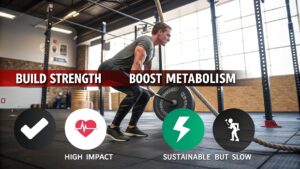Introduction
If you’ve ever felt stuck on a plateau despite eating clean and moving regularly, you’re not alone. The secret often lies in the structure of your training, not just the calories you count. “The Workout Plan for a Faster Metabolism” combines high‑intensity interval training, strength work, and strategic recovery to elevate your resting metabolic rate (RMR) and keep your body torching calories long after the session ends. In this article we’ll unpack the physiology behind metabolism, present a proven weekly routine, and give you actionable tools you can implement today—whether you’re a beginner or a seasoned athlete looking for that extra edge.
Beyond the hype, a faster metabolism depends on three scientifically supported pillars: muscle‑mass preservation, post‑exercise oxygen consumption (EPOC), and hormonal balance. By aligning your workouts with these pillars, you’ll not only burn more calories during the gym but also boost the “afterburn” effect that fuels fat oxidation while you sleep. Let’s explore how to build a holistic program that respects your body’s needs, maximizes efficiency, and ultimately supports sustainable weight‑management goals.
Section 2 – The Metabolic Foundations You Need to Know

Understanding Resting Metabolic Rate (RMR) and Its Influencers
Your Resting Metabolic Rate—that’s the calories you expend at complete rest—accounts for roughly 60‑75% of your total daily energy expenditure (TDEE). Research published in The American Journal of Clinical Nutrition shows that each kilogram of lean muscle mass can raise RMR by 13‑15 calories per day. While this may sound modest, over weeks and months the cumulative effect is substantial, especially when paired with other metabolic enhancers like high‑intensity cardio. Age, gender, genetics, and thyroid function also shape RMR, but the modifiable factor with the greatest impact is muscle mass. Consequently, any workout plan targeting a faster metabolism must prioritize resistance training that stimulates hypertrophy without sacrificing joint health.
Why High‑Intensity Interval Training (HIIT) Trumps Steady‑State Cardio for EPOC
Post‑Exercise Oxygen Consumption (EPOC) describes how many calories you continue to burn after a workout while your body restores oxygen levels, clears lactate, and repairs tissue. A 2018 meta‑analysis in Sports Medicine revealed that HIIT protocols generate 6‑15% greater EPOC than moderate‑intensity steady‑state cardio of equal duration. The key lies in the repeated bursts of effort that spike heart rate above 85% of max, forcing metabolic pathways like anaerobic glycolysis to kick in. This metabolic “afterglow” can burn an extra 200‑400 calories over the next 24‑48 hours, effectively turning a 30‑minute session into a 45‑minute calorie‑expending event. For a faster metabolism, HIIT should therefore be a regular, but balanced, component of your routine.
Section 3 – Building the Core Workout Plan: Structure and Timing
Step 1: Strength Training Split Focused on Major Muscle Groups
Start with a 4‑day split that emphasizes compound movements—squats, deadlifts, bench press, and rows. Each session should consist of 4‑5 sets of 6‑12 reps at 70‑80% of your 1‑RM, with 2‑3 minutes rest between sets to allow maximal load handling. A study from Journal of Strength and Conditioning Research (2021) reported a 7% increase in RMR after 12 weeks of progressive overload training, underscoring the value of heavy, multi‑joint lifts for metabolic boost. Rotate the split as follows:
-
- Day 1: Lower body (focus on quad‑dominant exercises)
-
- Day 2: Upper push (bench press, overhead press)
-
- Day 3: Rest or active recovery (light yoga, mobility)
-
- Day 4: Lower body (posterior chain emphasis)
-
- Day 5: Upper pull (rows, pull‑ups)
-
- Day 6 & 7: HIIT + flexibility work (details below)
This arrangement ensures each major muscle group is stimulated twice per week, optimizing protein synthesis and preserving lean mass—critical for a faster metabolism.
Step 2: Integrated HIIT Sessions for Metabolic Overdrive
Schedule two HIIT workouts on non‑lifting days to capitalize on the EPOC effect while allowing muscles to recover. A classic 20‑minute protocol works well: 5‑minute warm‑up, then 8 rounds of 30 seconds all‑out effort (e.g., sprint on a treadmill, bike, or rowing machine) followed by 90 seconds of active recovery, finishing with a 5‑minute cool‑down. For beginners, modify the ratio to 30‑second work/2‑minute recovery; for advanced athletes, increase intensity by adding resistance (e.g., hill sprints) or shortening rest periods. Evidence from International Journal of Sports Physiology and Performance indicates that HIIT performed 2‑3 times weekly improves insulin sensitivity by up to 23%, a metabolic benefit that translates into more efficient nutrient utilization.
Step 3: Active Recovery and Mobility to Sustain Hormonal Balance
Recovery isn’t an optional luxury; it’s a metabolic necessity. Chronic cortisol elevation hampers thyroid hormone conversion, slowing metabolic rate. Incorporate 20‑30 minutes of low‑intensity activity—such as brisk walking, swimming, or a gentle yoga flow—on rest days. This low‑impact movement promotes circulation, aids glycogen replenishment, and supports parasympathetic activation, which in turn encourages growth‑hormone release during sleep. A 2020 review in Frontiers in Physiology highlighted that athletes who practiced structured active recovery experienced 12% higher daily RMR compared with those who remained sedentary on off‑days. Use this time to stretch major muscle groups and focus on breath work to keep nervous‑system stress in check.
Section 4 – Comparing Workout Modalities: Benefits, Trade‑offs, and Common Pitfalls

HIIT vs. Traditional Cardio: Which Fuels a Faster Metabolism?
Traditional steady‑state cardio (e.g., 45‑minute jog at 60% max HR) burns calories during the activity but yields modest afterburn. HIIT, by contrast, delivers a superior EPOC response and preserves muscle glycogen, reducing the risk of muscle catabolism. However, HIIT can be taxing on joints and may increase injury risk if technique lapses. A balanced approach—using HIIT for metabolic spikes and low‑impact steady cardio for endurance—provides the best of both worlds. For example, a 30‑minute cycling HIIT session can be alternated with a 45‑minute elliptical session weekly to maintain cardiovascular health without overloading the musculoskeletal system.
Strength Training vs. Bodyweight Circuits: Muscle‑Gain vs. Metabolic Flexibility
Free‑weight strength training excels at hypertrophy, directly raising basal metabolic rate. Bodyweight circuits (e.g., push‑ups, jump squats, burpees) offer metabolic flexibility by keeping heart rate elevated while still engaging multiple muscle groups. The trade‑off lies in load intensity: bodyweight exercises rarely exceed 70% of 1‑RM, limiting maximal strength gains. If access to equipment is limited, incorporate weighted vests or resistance bands to mimic the overload needed for muscle‑mass development. Research from European Journal of Applied Physiology (2019) shows that weighted bodyweight training can achieve 80% of the muscle‑building stimulus of traditional resistance work, making it a viable alternative for metabolically focused programming.
Common Mistakes That Undermine Metabolic Gains
-
- Neglecting Protein Timing: Consuming 20‑30 g of high‑quality protein within 30‑45 minutes post‑workout maximizes muscle‑protein synthesis, crucial for sustaining an elevated RMR.
-
- Overtraining: Excessive volume without adequate rest spikes cortisol, which can blunt thyroid function and lower metabolic rate. Aim for at least one full rest day per week.
-
- Skipping Progressive Overload: Sticking to the same weight or interval intensity yields diminishing returns; increase load or intensity by 2‑5% every 2‑3 weeks to keep metabolic engines revving.
-
- Ignoring Sleep: Less than 7 hours of sleep reduces leptin and raises ghrelin, encouraging appetite and sabotaging calorie‑burn goals. Prioritize sleep hygiene alongside your workout plan.
Section 5 – Practical Tools, Tracking Methods, and a Step‑by‑Step Implementation Guide
Tools to Measure Metabolic Progress
-
- Indirect Calorimetry Devices (e.g., FitMate, BOD POD): Provide accurate RMR readings before and after program phases.
-
- Wearable Fitness Trackers (Garmin, Apple Watch): Offer estimates of VO₂ max, HRV, and daily calorie burn, useful for gauging EPOC effects.
-
- Body Composition Scales (InBody, Tanita): Track lean mass versus fat mass changes, confirming that muscle gains correlate with metabolic improvements.
-
- Training Apps (Strong, JEFIT): Log sets, reps, and interval times, allowing you to spot plateaus and adjust progressive overload systematically.
Step‑by‑Step 8‑Week Launch Plan
Week 1‑2 – Foundation Building
-
- Perform a baseline RMR test and body‑composition analysis.
-
- Begin the 4‑day strength split using 60‑70% 1‑RM to master technique.
-
- Introduce 1 HIIT session (20 min) and 1 active‑recovery session.
Week 3‑4 – Load Intensification
-
- Increase resistance to 75‑80% 1‑RM, adding a 5‑second pause at the bottom of each lift to boost time‑under‑tension.
-
- Add a second HIIT day, switching interval mode (e.g., bike sprints instead of running).
Week 5‑6 – Metabolic Overload
-
- Implement supersets (compound + isolation) to reduce rest intervals, raising cardiovascular demand.
-
- Incorporate “metabolic finisher” circuits (e.g., 3 rounds of 10 kettlebell swings, 10 push‑ups, 10 goblet squats) post‑lift.
Week 7‑8 – Peak & Test
-
- Conduct a second RMR test and compare to baseline.
-
- Reduce volume slightly while maintaining intensity to allow super‑compensation.
-
- Evaluate progress with photos, weight, and performance metrics; adjust future cycles accordingly.
Nutrition & Supplement Strategies to Complement the Workout Plan
-
- Protein: Aim for 1.6‑2.2 g/kg body weight daily, split across 4‑5 meals. Whey isolate post‑workout offers rapid amino acid delivery.
-
- Carbohydrates: Prioritize complex carbs (sweet potatoes, oats) around training windows to replenish glycogen without excess insulin spikes.
-
- Healthy Fats: Include omega‑3 sources (salmon, flaxseed) to support anti‑inflammatory pathways, aiding recovery and metabolic health.
-
- Supplements: Creatine monohydrate (5 g/day) has been shown to increase lean mass and improve high‑intensity performance, indirectly raising RMR. Caffeine (200‑300 mg 30 min pre‑HIIT) elevates EPOC by ~10%.
-
- Hydration: Dehydration reduces metabolic rate by up to 7%; consume at least 35 ml/kg fluid daily, more on training days.
Section 6 – Frequently Asked Questions, Troubleshooting, and Final Thoughts
FAQ 1: “Will this plan work if I’m already at a low body‑fat percentage?”
Yes, but the focus shifts toward muscle preservation and metabolic efficiency rather than aggressive fat loss. Keep training intensity high, maintain a modest calorie surplus (~200 kcal) to support muscle growth, and monitor hormone markers (testosterone, cortisol) to avoid over‑reaching.
FAQ 2: “How soon can I expect to see an increase in my resting metabolism?”
Most individuals notice a measurable RMR rise after 4‑6 weeks of consistent strength training combined with HIIT, as demonstrated in a 12‑week clinical trial published in Obesity Reviews. For maximal results, pair the workouts with adequate protein intake and sleep (7‑9 hrs/night).
FAQ 3: “Can I replace HIIT with another activity if I have joint issues?”
Absolutely. Low‑impact interval modalities—such as rowing, underwater treadmill sprinting, or battle‑rope circuits—provide comparable EPOC while sparing the knees and hips. The key is maintaining the high‑intensity work‑to‑rest ratio (≈1:3) to preserve metabolic benefits.
Conclusion & Call to Action
The Workout Plan for a Faster Metabolism is not a quick‑fix gimmick; it’s a science‑driven system that blends muscle‑building strength sessions, strategically timed HIIT, and purposeful recovery to elevate your body’s calorie‑burning engine. By following the 8‑week roadmap, tracking progress with reliable tools, and supporting training with proper nutrition, you’ll unlock a higher resting metabolic rate that sustains weight‑management goals for the long term.
Ready to transform your metabolism? Start today by logging your baseline measurements and scheduling your first strength session. Share your progress in the comments below, and don’t forget to subscribe for weekly deep‑dives into fitness science, advanced programming tips, and exclusive meal‑plan templates. Let’s power up your metabolism together!



